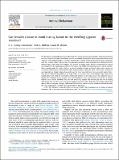Files in this item
Can females choose to avoid mating failure in the seed bug Lygaeus simulans?
Item metadata
| dc.contributor.author | Greenway, E. V. (Ginny) | |
| dc.contributor.author | Balfour, Vicki L. | |
| dc.contributor.author | Shuker, David M. | |
| dc.date.accessioned | 2017-06-07T09:30:13Z | |
| dc.date.available | 2017-06-07T09:30:13Z | |
| dc.date.issued | 2017-07 | |
| dc.identifier | 249730731 | |
| dc.identifier | 302086b2-ebcf-4b78-85ff-a46b24f55080 | |
| dc.identifier | 85020264523 | |
| dc.identifier | 000405821200007 | |
| dc.identifier.citation | Greenway , E V , Balfour , V L & Shuker , D M 2017 , ' Can females choose to avoid mating failure in the seed bug Lygaeus simulans ? ' , Animal Behaviour , vol. 129 , pp. 61-69 . https://doi.org/10.1016/j.anbehav.2017.05.004 | en |
| dc.identifier.issn | 0003-3472 | |
| dc.identifier.other | ORCID: /0000-0003-4203-3057/work/140362641 | |
| dc.identifier.uri | https://hdl.handle.net/10023/10927 | |
| dc.description | We thank the Natural Environmental Research Council (Ph.D. studentship to E.V.G.) and the Association for the Study of Animal Behaviour (Undergraduate Project Scholarship awarded to V.L.B.) for funding. | en |
| dc.description.abstract | It is becoming increasingly clear that copulation does not necessarily always lead to offspring production in many organisms, despite fertilization success presumably being under both strong natural and sexual selection. In the seed bug Lygaeus simulans, between 40% and 60% of copulations fail to produce offspring, with this ‘mating failure’ representing a significantly repeatable male-associated trait. Mating has been demonstrated to be costly in this species and, as such, we might expect females to minimize the chance of mating failure by displaying a preference for males with higher insemination success where possible. After assaying males for mating failure, we asked whether females preferred males with a history of successful inseminations versus unsuccessful inseminations in pairwise mate choice trials. Contrary to our expectations, females showed no preference for more successful over less successful males. Moreover, females showed no preference for larger males in the choice trials, even though larger males were significantly more likely to successfully inseminate females in the initial assay. This apparent lack of female precopulatory choice suggests that postcopulatory choice mechanisms may be key to mating failure in this species. However, this does not necessarily explain why females pay the cost of mating with males they will then reject via postcopulatory processes. More generally, our results suggest that mating failure may play a largely underappreciated role in mating systems evolution, influencing both the cost of choosiness, and the costs and benefits of polyandry. | |
| dc.format.extent | 9 | |
| dc.format.extent | 699193 | |
| dc.language.iso | eng | |
| dc.relation.ispartof | Animal Behaviour | en |
| dc.subject | Mating failure | en |
| dc.subject | Cryptic female choice | en |
| dc.subject | Sexual selection | en |
| dc.subject | Polyandry | en |
| dc.subject | Insect reproduction | en |
| dc.subject | QH301 Biology | en |
| dc.subject | QL Zoology | en |
| dc.subject | NDAS | en |
| dc.subject.lcc | QH301 | en |
| dc.subject.lcc | QL | en |
| dc.title | Can females choose to avoid mating failure in the seed bug Lygaeus simulans? | en |
| dc.type | Journal article | en |
| dc.contributor.institution | University of St Andrews. School of Biology | en |
| dc.contributor.institution | University of St Andrews. Scottish Oceans Institute | en |
| dc.contributor.institution | University of St Andrews. Institute of Behavioural and Neural Sciences | en |
| dc.contributor.institution | University of St Andrews. Centre for Biological Diversity | en |
| dc.identifier.doi | 10.1016/j.anbehav.2017.05.004 | |
| dc.description.status | Peer reviewed | en |
| dc.date.embargoedUntil | 2017-06-06 |
This item appears in the following Collection(s)
Items in the St Andrews Research Repository are protected by copyright, with all rights reserved, unless otherwise indicated.

